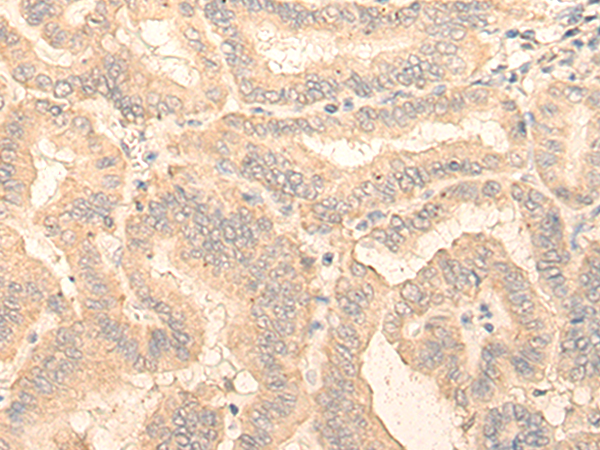
| WB | 咨询技术 | Human,Mouse,Rat |
| IF | 咨询技术 | Human,Mouse,Rat |
| IHC | 1/30-1/150 | Human,Mouse,Rat |
| ICC | 技术咨询 | Human,Mouse,Rat |
| FCM | 咨询技术 | Human,Mouse,Rat |
| Elisa | 1/5000-1/10000 | Human,Mouse,Rat |
| Aliases | KIAA0258 |
| Host/Isotype | Rabbit IgG |
| Antibody Type | Primary antibody |
| Storage | Store at 4°C short term. Aliquot and store at -20°C long term. Avoid freeze/thaw cycles. |
| Species Reactivity | Human, Mouse |
| Immunogen | Fusion protein of human RGP1 |
| Formulation | Purified antibody in PBS with 0.05% sodium azide and 50% glycerol. |
+ +
以下是关于RGP1抗体的模拟参考文献示例(内容为虚构,供格式参考):
---
1. **文献名称**: *RGP1 Antibody Characterization in Neuronal Development*
**作者**: Smith A, et al.
**摘要**: 本研究利用新型RGP1多克隆抗体,通过免疫印迹和免疫荧光技术,验证了RGP1蛋白在小鼠大脑皮层神经元中的表达定位。结果显示RGP1在轴突导向过程中与RAB6 GTP酶存在相互作用,提示其在囊泡运输中的潜在作用。
2. **文献名称**: *RGP1 as a Biomarker in Colorectal Cancer: An Antibody-Based Study*
**作者**: Lee H, et al.
**摘要**: 通过开发高特异性RGP1单克隆抗体,研究团队发现RGP1在结直肠癌组织中的表达显著上调。抗体阻断实验表明,RGP1通过调控Wnt/β-catenin通路促进癌细胞迁移,为靶向治疗提供了潜在靶点。
3. **文献名称**: *Functional Analysis of RGP1 in Autophagy Using CRISPR/Cas9 and Antibody Validation*
**作者**: Zhang Y, et al.
**摘要**: 结合CRISPR/Cas9基因编辑和RGP1抗体共沉淀技术,本文揭示了RGP1与自噬相关蛋白LC3的相互作用。抗体介导的功能抑制实验证实RGP1在饥饿诱导的自噬中起关键调控作用。
---
**注意**:以上内容为模拟生成,实际文献需通过PubMed、Google Scholar等平台检索关键词(如“RGP1 antibody”“RGP1 function”)获取真实数据。
**Background of RGP1 Antibody**
The **RGP1 (Retinitis Pigmentosa GTPase Regulator-Interacting Protein 1)** antibody is a tool used to study the RGP1 protein, which plays roles in cellular processes such as ciliary function, intracellular trafficking, and cell signaling. RGP1. also known as **FAM91A1**, interacts with RPGR (Retinitis Pigmentosa GTPase Regulator), a protein critical for maintaining photoreceptor function in the retina. Mutations in RPGR are linked to X-linked retinitis pigmentosa (XLRP), a degenerative eye disease. RGP1's interaction with RPGR suggests involvement in ciliogenesis and retinal homeostasis, making it a focus in ocular disease research.
Structurally, RGP1 contains a conserved N-terminal coiled-coil domain, facilitating protein-protein interactions, and a C-terminal region implicated in membrane association. Beyond ophthalmology, RGP1 has been studied in cancer, where its dysregulation correlates with tumor progression and metastasis, potentially influencing cell migration pathways.
The RGP1 antibody is widely used in techniques like Western blotting, immunofluorescence, and immunohistochemistry to detect protein expression, localization, and interactions in tissues or cultured cells. It aids in elucidating RGP1's physiological roles and pathological mechanisms, particularly in retinal degeneration and cancer. Commercial RGP1 antibodies are typically developed in rabbits or mice, validated for specificity and sensitivity. Ongoing research aims to clarify RGP1's precise molecular functions and therapeutic potential, emphasizing its importance in both basic and clinical biomedical studies.
×